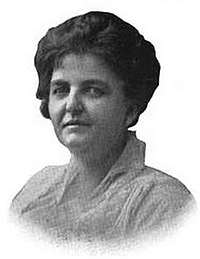Temple Bailey
Irene Temple Bailey (February 24, 1869 – July 6, 1953)[1] was a popular American novelist and short story writer.[2][3]
Temple Bailey | |
|---|---|
 | |
| Born | February 24, 1869 Petersburg, Petersburg City, Virginia, USA |
| Died | July 6, 1953 (aged 84) Washington, District of Columbia, District Of Columbia, USA |
| Occupation | Writer (novelist) |
| Nationality | American |
| Period | 20th century |
| Genre | Romance, fiction |
Beginning around 1902, Temple Bailey was contributing stories to national magazines such as The Saturday Evening Post, Cavalier Magazine, Cosmopolitan, The American Magazine, McClure's, Woman's Home Companion, Good Housekeeping, McCall's and others.
In 1914, Bailey wrote the screenplay for the Vitagraph Studios film Auntie, and two of her novels were filmed.[4] She also had three of her books on the list of bestselling novels in the United States in 1918, 1922, and 1926 as determined by Publishers Weekly.
Bailey never married. She died at her apartment in Washington, D.C. on July 6, 1953. Her obituary in the New York Post estimated that her novels had sold three million copies, making her among the best paid writers in the world, and that Cosmopolitan had once given her $325,000 for three serial novels and a group of short stories.[5][6]
Bibliography

- Judy (1907)
- Glory of Youth (1913)
- Contrary Mary (1914)
- A Girl's Courage (1916)
- Adventures in Girlhood (1917)
- Mistress Anne (1917)
- The Tin Soldier (1918) - No.8 for the year 1919 in the U.S.
- Trumpeter Swan (1920)
- The Gay Cockade (1921)
- The Dim Lantern (1922) - No.5 for the year 1923 in the U.S.
- Peacock Feathers (1924) - made into a motion picture
- Holly Hedge, and other Christmas stories (1925)
- The Blue Window (1926)[7] - No.10 for the year 1926 in the U.S.
- Wallflowers (1927) - made into a motion picture
- Silver Slippers (1928)
- Star in the Well; a Christmas story (1928)
- Burning Beauty (1929)
- Wild Wind (1930)
- So this Is Christmas (1931)
- Little Girl Lost (1932)[8]
- Enchanted Ground (1933)
- Radiant tree, and other stories (1934)
- Fair as the Moon (1935)
- I've Been To London (1937)
- Tomorrow's Promise (1938)
- The Blue Cloak (1941)[9]
- Pink Camellia (1942)
- Red Fruit (1945)
Filmography
- Auntie (1914)
- Peacock Feathers (1925)
- Wallflowers (1928)
References
- "Irene Temple Bailey". Find A Grave.
- Clayton, Marion E. (15 July 1928). Noted Author Tells About Life, Writing on Visit in Valley, Utica Observer-Dispatch
- Alden, Alice (17 February 1933). Is Ideal Love Out of Fashion, North Shore Daily Journal (Flushing, New York) (syndicated article)
- "Temple Bailey". IMDb.com.
- (8 July 1953). Temple Bailey, Novelist, New York Post, p. 59.
- (8 July 1953). Round About Town, Jamestown Post-Journal (mention of her death, notes she was a native of Petersburg, Virginia)
- "Alone in a Big City; The Blue Window". The New York Times. 12 December 1926.
- "Cinderella Again; Little Girl Lost". The New York Times. 30 October 1932.
- Charlotte, Dean (16 March 1941). "The Blue Cloak". The New York Times.
External links
| Wikisource has original works written by or about: Irene Temple Bailey |
- Works by Temple Bailey at Project Gutenberg
- Works by Temple Bailey at Faded Page (Canada)
- Works by or about Temple Bailey at Internet Archive
- Works by Temple Bailey at LibriVox (public domain audiobooks)
